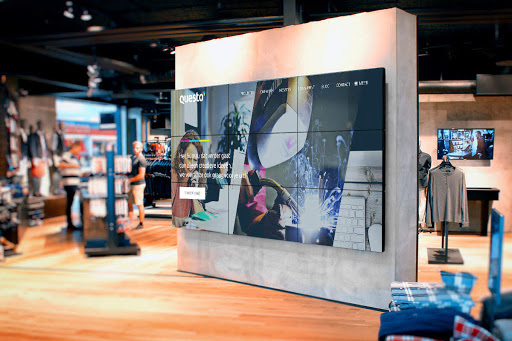Signs are some of the most flexible advertising and communication tools a business can invest in. With the right sign, you can advertise an event, a deal, a new product or even your entire business. You can also use signs to convey important information — like store hours or where to find a certain resource.
Is Digital Signage the Key to Your Business's Success? Share on X
While print signs are the most common, digital signage provides some serious benefits. With a digital sign, you can swap out graphics on the fly, switching up the information you show off as needed, or create dynamic displays that rotate a set of graphics, images or animations.

These four methods of digital sign use show how essential the right signage can be to a business’s success — plus, how you may be able to implement these signs in a marketing or communications strategy.
1. Digital Signs Provide Visual Interest
Signs are important for any marketing campaign that needs to capture customers through offline channels. Digital signs provide a few benefits that make them one of the better options available.
A three-month Intel study on consumer behavior found that that digital signs in a bank captured 400% more attention than static signs, like paper signs. This is likely due to the advanced features that digital signs can offer. Movement, for example, is a big advantage when it comes to catching attention. The moving graphics that digital signs can show off may easily outclass paper signs when it comes to capturing the gaze of your audience.
Digital signs outfitted with touch screens or other sensors can also offer interactive experiences by allowing customers to browse a menu, fill out a form while they wait or even play a game.
3. Rotating Information
One of the biggest advantages of digital signage is that you can change the displayed information on-the-fly. This means it’s easy to highlight new deals, products or events as needed, with no lead time required for printing shop services.
With a little bit of creativity, digital signs can open up a wide range of possibilities as a result. A restaurant with counter service, for example, can use horizontally aligned digital signs to display a menu above their point of sale. These signs will provide great menu visibility to customers standing in line. They’ll also allow the business to create a rotating menu display, swapping from one menu image to another to show off a wider range of items than they could with static displays.
Just about any business that needs to display information can use digital signage in the same way. A hotel with multiple floors could use rotating digital signs to display multiple level maps for easy navigation. A retailer could invest in a large display and rotate different images, animations or graphics as old deals expire and new ones are offered.
If multiple deals are active at the same time, rotating graphics can also allow that retailer to show off those deals with just one display.
3. Digital Signs Are Cost-Effective
While they’ll likely require a bigger upfront investment than a paper sign, digital signs are highly cost-effective in the long run. Because you won’t need to swap out the sign, you’ll save on every sign you would have needed to print in order to display new information.
The flexibility of digital signage also means you can repurpose displays as needed. If you ever find that you don’t need as many displays as you have, you may be able to move and convert a display so that it shows important information — like the time, date, updates to store hours or the customer number being served.
For further savings, you can also sell ad space on those digital signs — making the business a little extra money on a display that would otherwise go unused, if it were static.
4. Digital Signs Can Unite Your Online and Offline Marketing
Digital signs can also help you create some extra cohesion between your online and offline marketing strategies.
For example, you could use a digital sign to provide a scrolling feed of reviews from TripAdvisor, Yelp or another platform to demonstrate a business’s commitment to service. You could also create a display showing which items customers have recently purchased. If your business offers personalized items, you could also use that space to show what real customers have come up with using the options you offer.
Digital signage can also promote social media accounts, blogs, websites or other elements of a business’s online presence.
Because digital signs can do almost everything online ads can — like animations, sound and interactive experiences — they can also help you bring elements of an online ad campaign into the real world. This could help you provide some consistency in campaigns that rely on both online and offline marketing strategies.
When customers see the same campaign in-store and online, they may also be more likely to create a connection between the two channels. As a result, with the right signs and strategy, you can bring your online and offline marketing strategies a little closer together to help ensure a smoother omnichannel experience for your audience.
Using Digital Signs to Boost Business Communications
The right sign in the right place can make a massive difference in a business’s marketing or comms strategy. Digital signage offers some serious advantages over print or static signs — like interactive experiences, rotating image sets and live displays. In any situation where a business needs to quickly get across some kind of information, digital signs can provide a cost-effective and visually interesting solution.
Recommended Read:
HOW TO USE VIDEO MARKETING FOR BRAND AWARENESS IN 2021?
BEST LINK BUILDING TECHNIQUES FOR NEWBIE BLOGGERS
20 CREATIVE WEB DESIGN TOOLS TO CREATE STUNNING WEBSITES
General FAQs
Digital signage is a centrally controlled, content distribution platform by which to playback digital content to one or many displays or screens. Digital signage is best explained as a form of electronic display that shows television programming, menus, information, advertising, and other messages.
Digital signage’s content is powered by a media player or system-on-a-chip which pushes content to a display. Users can then manage the content with a content management system, either on-site or within the cloud to change up content on the fly.
Digital signage is such a powerful tool because it can be implemented in countless ways. A digital signage provider can help you explore the ways to use digital to inform, entertain, educate, and communicate with customers in your store. Signage can inform consumers of new releases, sales, and product information.




